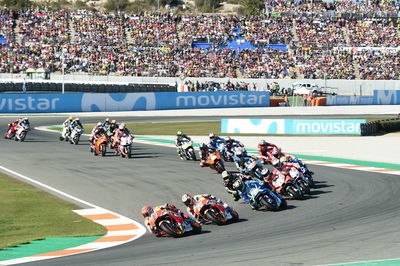Michelin talk great racing, front stress, quality control
The last two seasons of MotoGP have seen an unprecedented number of race winners and close racing.
A record nine riders won a grand prix during the 2016 season, dropping to a still respectable five different winners in 2017.
But while the variety reduced, probably due to a greater understanding of the tyres, the racing at the front became much closer. Only two races were won by a margin of less than one-second in 2016, rocketing to eight races in 2017.

The last two seasons of MotoGP have seen an unprecedented number of race winners and close racing.
A record nine riders won a grand prix during the 2016 season, dropping to a still respectable five different winners in 2017.
But while the variety reduced, probably due to a greater understanding of the tyres, the racing at the front became much closer. Only two races were won by a margin of less than one-second in 2016, rocketing to eight races in 2017.
Exactly why the last two years have been so exciting is a matter for debate, but what's clear is that two major technical changes occurred for the start of 2016; Michelin replaced Bridgestone as exclusive tyre supplier and a single ECU became mandatory.
"We came back with humility, we knew there was a lot of work to be done. But I also want to congratulate the Michelin teams, they’ve done a great job and we've seen fantastic racing over the past two years," said Pascal Couasnon, director of Michelin Motorsport.
"I think it's shown that tyre performance and tyre strategy can really contribute to the show. And that's what we want. Great racing is very important to us."
On the back of the past two seasons, a new five-year contract extension was announced at this year's Australian MotoGP.
"The fact that we've renewed for five years is a great show of confidence," Couasnon added.
"We will continue to work hard, but I think the strategy of having multiple tyre choices, giving the opportunity to every bike and rider to win - we saw nine riders winning in the first year and many this year, is a good sign."
Dorna CEO Carmelo Ezpeleta also credited Michelin for helping deliver close competition.
"I think that honestly in the name of all the MotoGP family we say thanks for what Michelin have done in the last two years, which is helping a lot the competitivity of the championship.
"We are much, much better than two years ago."
Michelin 'in competition against themselves'
Michelin claimed its first premier-class motorcycle grand prix victory with Jack Findlay in 1973 and had taken 360 wins by the time it left MotoGP at the end of 2008, when Bridgestone took on MotoGP's first single tyre supply.
"We saw that competition between different tyre manufacturers impacted a lot on the championship and in our opinion it was not correct," Ezpeleta explained of the move to only one supplier.
"This is a championship of motorbikes and riders, so we decided to go to the single tyre rule… and Michelin at that time decided that they don't want to be involved.
"But we always felt that Michelin is one of the best tyre manufacturers in the world and, if I may say, during these two years the way we have collaborated with Michelin has been fantastic.
"Why? Everybody can make mistakes and we remember other mistakes [by Bridgestone at Phillip Island] and the behaviour of the other manufacturer was completely different than when Michelin has any problem.
"Michelin has always been committed. They don't compete with other manufacturers, but they are in competition against themselves now, trying to be a real single tyre manufacturer to six different bike manufacturers, which has never happened before.
"It's for that reason that we renewed with them and didn't consider any other possibilities."
Michelin's most difficult challenge…
But it hasn't all been smiles and back-slapping, the very nature of MotoGP means there were intense technical challenges to be overcome.
In Michelin's case, barring some early delaminations for Loris Baz and Scott Redding, it was the front tyre that proved most problematic, graphically illustrated by testing accidents and spelt-out by frank feedback from the riders.
"The most difficult [challenge], which was pointed out very quickly by the riders, was to improve our front tyre," recalled Michelin Racing technical director Nicolas Goubert, who will become executive director of the upcoming electric motorcycle championship, the FIM Moto-e World Cup.
"During the long period of time we were away from MotoGP the bikes had evolved and there is a lot more stress on the front tyres, a lot harder braking, and we knew from the first test in September 2014 that we would have to work a lot on the front.
"One of the difficulties is that you can work with [your own] test riders, using many types of bikes. Then you can do work with the official MotoGP test riders, which enables you to go up to a different limit.
"But if you really want to test a MotoGP front tyre you have to have a MotoGP rider on the bike.
"We knew that anyway and when we signed the contract and discussed how we would get ready with Carmelo in mid-2014, we agreed that in the 2015 season we would have three days, during which we would ask the MotoGP riders - using at that time a different tyre brand [Bridgestone] - to jump on our bikes to give us direction. And that was mainly for the front.
"Three days is not a lot. Especially when the previous day the guys were running on a different tyre brand and they know the following weekend they will be on that brand again.
"They don’t want to spend time on a different set-up and they have only short periods of time. They don't want to crash because of course they are doing a championship and it was very difficult for them.
"So I thank the riders and teams to have agreed to do that, because it was a big, big help.
"But it took us time to get to the right level. Already in 2016 we had made quite a big gap with the front tyres compared with what we had. But it was not enough and the riders asked us to keep concentrating on the front tyres for the 2017 season.
"We developed the new profile, then we adjusted the construction after the Jerez test and I would say from Mugello onwards the situation has been quite good, to the point where the teams asked us to keep that same front-tyre range for all of the 2018 season.
"That's what we will do, except a couple of adjustments for a few races."
Work to do on quality control…
With construction and compounds at the fine-tuning stage, the main area highlighted for future progress is quality control. In other words, ensuring all tyres of the same specification perform as equally as possible.
"Quality is key in racing and production tyres," said Goubert. "It's part of Michelin's image to provide high quality tyres at a high standard and of course we're doing everything to do the same here.
"The technical challenge was very high to come back here and I think after two years we've made a tremendous improvement, but we still have some work to do in terms of quality issues.
"We've improved a lot, but sometimes we still have criticism or requests from the riders saying that the performance of such-and-such tyres are not exactly the same. Sometimes it's not always true, but sometimes it is.
"So, we have to make everything possible to find out where [the difference] comes from and for it not to happen again. We're working very hard with our factories to control that. To make sure every single tyre is of the same specification and offers the same performance to the riders."
Pressed on how that might be done, Goubert replied:
"The manufacturing process, making sure that every component is exactly the same and that everything is done the same way. Basically, putting everything we can under control. You have many, many components in the composition of tyres, so that's a lot of areas to control and that's what we're trying to do."
Why there is no qualifying tyre in MotoGP…
Unlike the World Superbike championship, MotoGP does not have qualifying tyres, instead preferring to offer a wider range of race rubber.
"In the end you have a budget - which I would say is significant, but reasonable - and you want to use that money for something very useful," said Couasnon. "So we prefer to bring a third rear tyre than a qualifying tyre. Because we believe that it's more useful, to give the opportunity to as many riders as possible to win."
"At the beginning of the season Carmelo's team asked us to bring more tyre specifications," Goubert confirmed. "We made sure that all three specs could do the race with at least a few riders. And that's what's happening, it's what's made in some cases the racing closer."
The other reason is that building a tyre for one fast lap has little transferable technology.
"If we go to qualification tyres, I would say you go far away from technology you would use on the street. So that's not our objective," Goubert said. "We do racing to develop technology for production tyres. And that is also the reason we asked to change from 16.5 to 17-inch tyres, to be able to transfer technology more easily.
"There is a very easy reason why you will never see a 16.5, or 17.5, wheel on the road market: You have to have at least one-inch difference in the existing sizes. If you don't, it's possible to fit 17-inch tyres on 16.5 wheels and then you can be in deep trouble. So nobody wants to do that."












